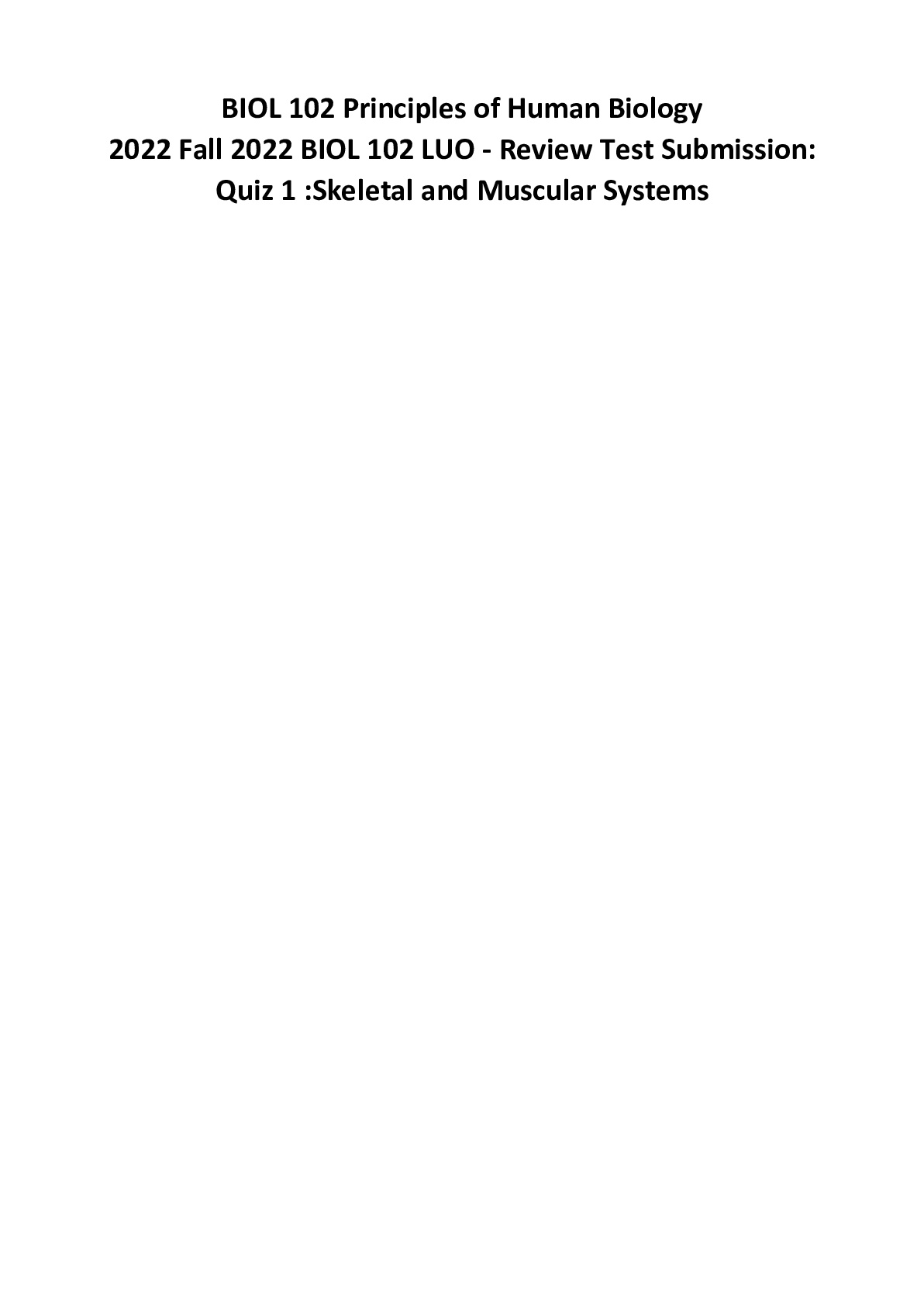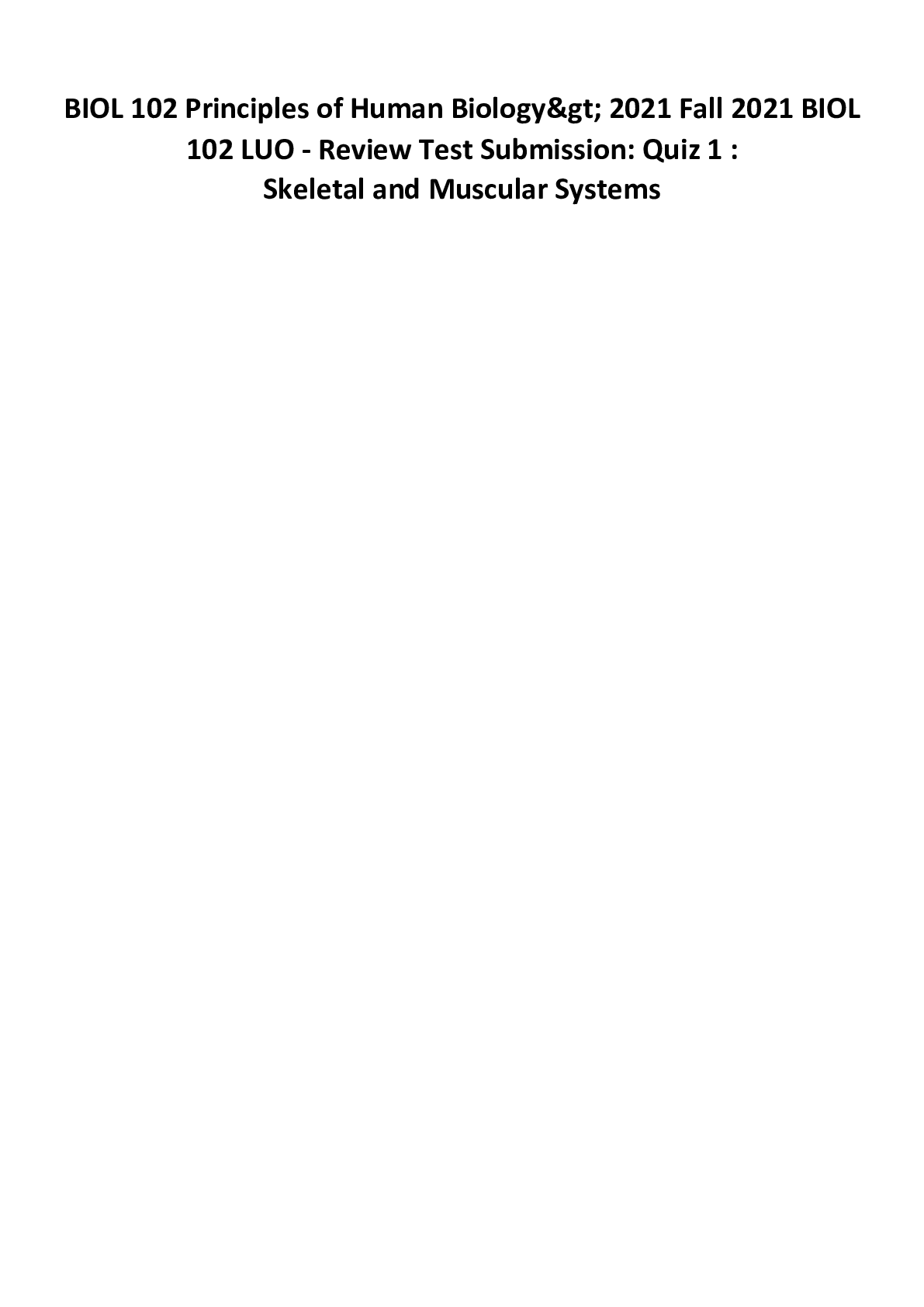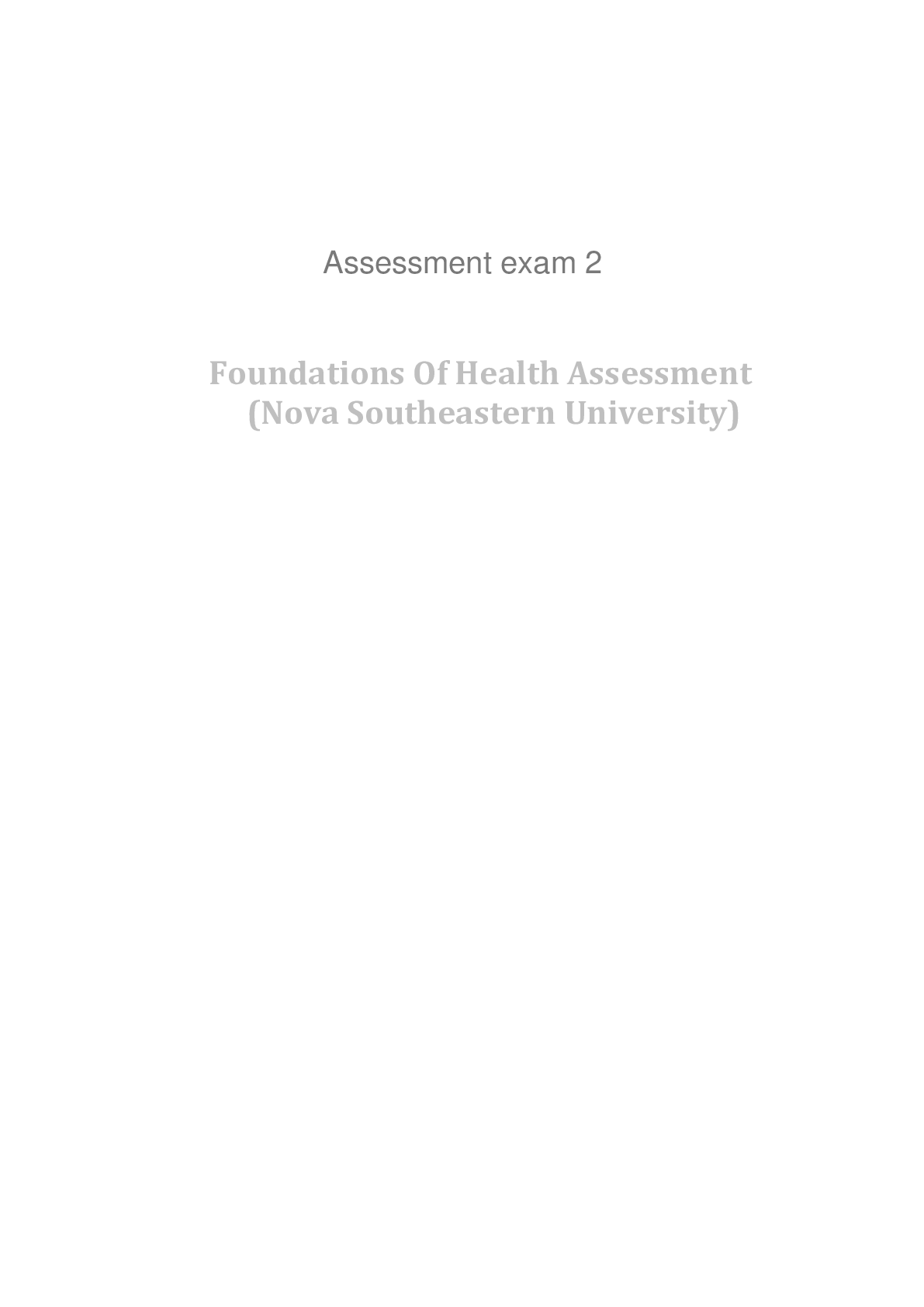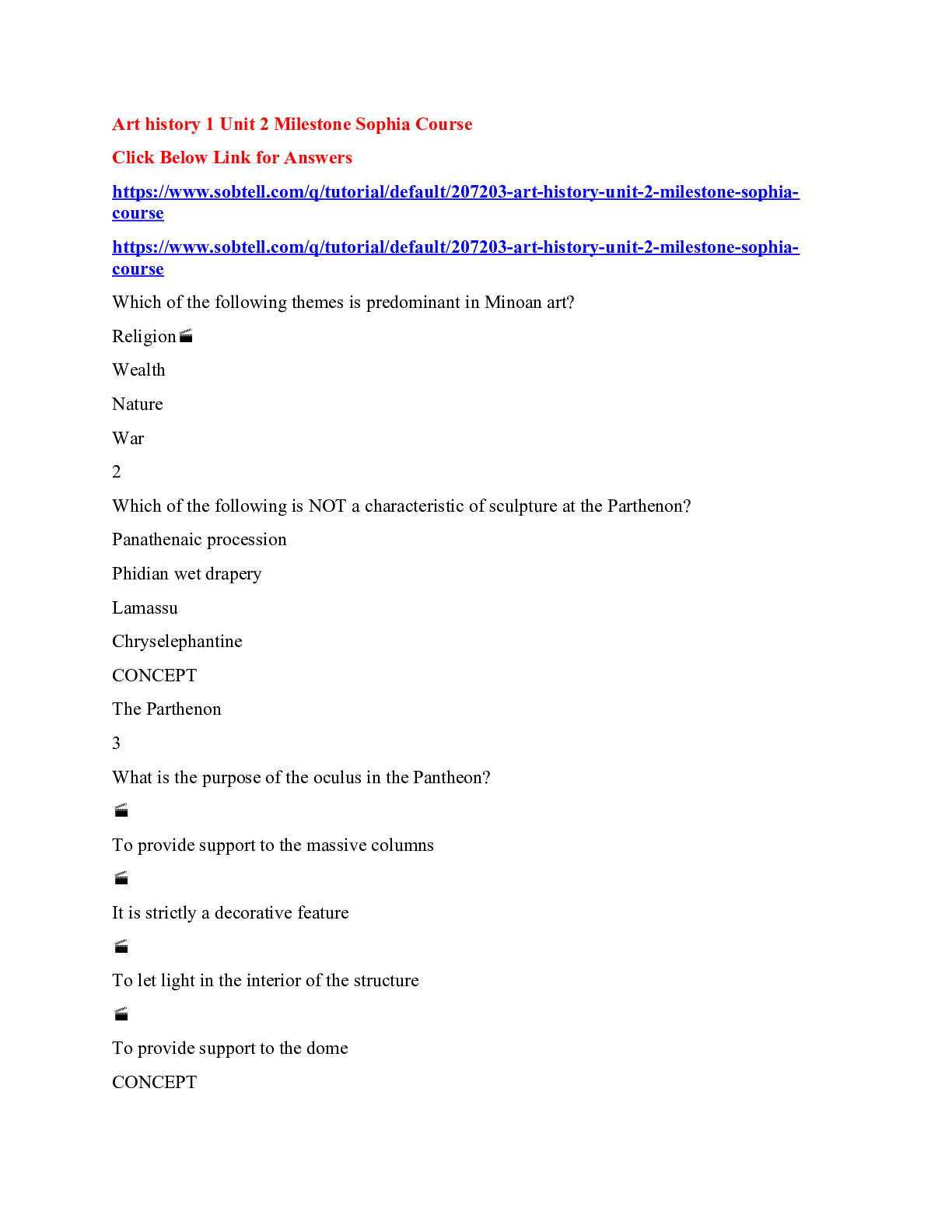*NURSING > EXAM REVIEW > Chapter 05: Cultural Implications Halter: Varcarolis’ Foundations of Psychiatric Mental Health Nur (All)
Chapter 05: Cultural Implications Halter: Varcarolis’ Foundations of Psychiatric Mental Health Nursing: A Clinical Approach, 8th Edition9All correct and explained responses)
Document Content and Description Below
Chapter 05: Cultural Implications Halter: Varcarolis’ Foundations of Psychiatric Mental Health Nursing: A Clinical Approach, 8th Edition MULTIPLE CHOICE 1. Which Western cultural feature may res... ult in establishing unrealistic outcomes for patients of other cultural groups? a. Interdependence b. Present orientation 60 c. Flexible perception of time d. Direct confrontation to solve problems ANS: D Directly confronting problems is a highly valued approach in the American culture but not part of many other cultures in which harmony and restraint are valued. American nurses sometimes mistakenly think that all patients should take direct action. Patients with other values will be unable to meet this culturally inappropriate outcome. Present orientation, interdependence, and a flexible perception of time are not valued in Western culture. These views are more predominant in other cultures. See relationship to audience response question. PTS: 1 DIF: Cognitive Level: Understand (Comprehension) REF: Page 5-33 (Table 5-4) TOP: Nursing Process: Planning MSC: Client Needs: Psychosocial Integrity 2. A psychiatric nurse leads a medication education group for Hispanic patients. This nurse holds a Western worldview and uses pamphlets as teaching tools. Groups are short and concise. After the group, the patients are most likely to believe a. the nurse was uncaring. b. the session was effective. c. the teaching was efficient. d. they were treated respectfully. ANS: A Hispanic individuals usually value relationship behaviors. Their needs are for learning through verbal communication rather than reading and for having time to chat before approaching the task. PTS: 1 DIF: Cognitive Level: Apply (Application) REF: Page 5-29 (Table 5-2) TOP: Nursing Process: Evaluation MSC: Client Needs: Psychosocial Integrity 3. To provide culturally competent care, the nurse should a. accurately interpret the thinking of individual patients. b. predict how a patient may perceive treatment interventions. c. formulate interventions to reduce the patient‘s ethnocentrism. d. identify strategies that fit within the cultural context of the patient. ANS: D The correct answer is the most global response. Cultural competence requires ongoing effort. Culture is dynamic, diversified, and changing. The nurse must be prepared to gain cultural knowledge and determine nursing care measures that patients find acceptable and helpful. Interpreting the thinking of individual patients does not ensure culturally competent care. Reducing a patient‘s ethnocentrism may not be a desired outcome. PTS: 1 DIF: Cognitive Level: Apply (Application) 61 REF: Page 5-11 TOP: Nursing Process: Planning/Outcomes Identification MSC: Client Needs: Psychosocial Integrity 4. A black patient, originally from Haiti, has a diagnosis of major depressive disorder. A colleague tells the nurse, ―This patient often looks down and is reluctant to share feelings. However, I‘ve observed the patient spontaneously interacting with other black patients.‖ Select the nurse‘s best response. a. ―Black patients depend on the church for support. Have you consulted the patient‘s pastor?‖ b. ―Encourage the patient to talk in a group setting. It will be less intimidating than one-toone interaction.‖ c. ―Don‘t take it personally. Black patients often have a resentful attitude that takes a long time to overcome.‖ d. ―The patient may have difficulty communicating in English. Have you considered using a cultural broker?‖ ANS: D Society expects a culturally diverse patient to accommodate and use English. Feelings are abstract, which requires a greater command of the language. This may be especially difficult during episodes of high stress or mental illness. Cultural brokers can be helpful with language and helping the nurse to understand the Haitian worldview and cultural nuances. PTS: 1 DIF: Cognitive Level: Apply (Application) REF: Page 5-8 TOP: Nursing Process: Implementation MSC: Client Needs: Psychosocial Integrity 5. A Haitian patient diagnosed with major depressive disorder tells the nurse, ―There‘s nothing you can do. This is a punishment. The only thing I can do is see a healer.‖ The culturally aware nurse assesses that the patient a. has delusions of persecution. b. has likely been misdiagnosed with depression. c. may believe the distress is the result of a curse or spell. d. feels hopeless and helpless related to an unidentified cause. ANS: C Individuals of African American or Caribbean cultures who have a fatalistic attitude about illness may believe they are being punished for wrongdoing or are victims of witchcraft or voodoo. They may be reticent to share information about curses with therapists. No data are present in the scenario to support delusions. Misdiagnosis more often labels a patient with depression as having schizophrenia. PTS: 1 DIF: Cognitive Level: Apply (Application) REF: Page 5-29 (Table 5-2) | Page 5-33 (Table 5-4) TOP: Nursing Process: Assessment MSC: Client Needs: Psychosocial Integrity 62 6. A group activity on an inpatient psychiatric unit is scheduled to begin at 1000. A patient, who was recently discharged from U.S. Marine Corps, arrives at 0945. Which analysis best explains this behavior? a. The patient wants to lead the group and give directions to others. b. The patient wants to secure a chair that will be close to the group leader. c. The military culture values timeliness. The patient does not want to be late. d. The behavior indicates feelings of self-importance that the patient wants others to appreciate. ANS: C Culture is more than ethnicity and social norms; it includes religious, geographic, socioeconomic, occupational, ability- or disability-related, and sexual orientation-related beliefs and behaviors. In this instance, the patient‘s military experience represents an aspect of the patient‘s behavior. The military culture values timeliness. The distracters represent misinterpretation of the patient‘s behavior and have no bearing on the situation. PTS: 1 DIF: Cognitive Level: Analyze (Analysis) REF: Pages 5-6, 33 (Table 5-4), 37 (Box 5-1) TOP: Nursing Process: Assessment MSC: Client Needs: Psychosocial Integrity 7. A nurse in the clinic has a full appointment schedule. A Hispanic American patient arrives at 1230 for a 1000 appointment. A Native American patient does not keep an appointment at all. What understanding will improve the nurse‘s planning? These patients are a. members of cultural groups that have a different view of time. b. immature and irresponsible in health care matters. c. acting-out feelings of anger toward the system. d. displaying passive-aggressive tendencies. ANS: A Hispanic Americans and Native Americans traditionally treat time in a way unlike the Western culture. They tend to be present-oriented; that is, they value the current interaction more than what is to be done in the future. If engaged in an activity, for example, they may simply continue the activity and appear later for an appointment. Understanding this, the nurse can avoid feelings of frustration and anger when the nurse‘s future orientation comes into conflict with the patient‘s present orientation. PTS: 1 DIF: Cognitive Level: Understand (Comprehension) REF: Pages 5-6, 29 (Table 5-2) TOP: Nursing Process: Assessment MSC: Client Needs: Psychosocial Integrity 8. The sibling of an Asian American patient tells the nurse, ―My sister needs help for pain. She cries from the hurt.‖ Which understanding by the nurse will contribute to culturally competent care for this patient? Persons of an Asian American heritage a. often express emotional distress with physical symptoms. b. will probably respond best to a therapist who is impersonal. c. will require prolonged treatment to stabilize these symptoms. 63 d. should be given direct information about the diagnosis and prognosis. ANS: A Asian Americans commonly express psychological distress as a physical problem. The patient may believe psychological problems are caused by a physical imbalance. Treatment will likely be short. The patient will probably respond best to a therapist who is perceived as giving. Asian Americans usually have strong family ties and value hope more than truth. PTS: 1 DIF: Cognitive Level: Understand (Comprehension) REF: Pages 5-10, 35 (Table 5-5) TOP: Nursing Process: Assessment MSC: Client Needs: Psychosocial Integrity 9. Which communication strategy would be most effective for a nurse to use during an assessment interview with an adult Native American patient? a. Open and friendly; ask direct questions; touch the patient‘s arm or hand occasionally for reassurance. b. Frequent nonverbal behaviors, such as gestures and smiles; make an unemotional face to express negatives. c. Soft voice; break eye contact occasionally; general leads and reflective techniques. d. Stern voice; unbroken eye contact; minimal gestures; direct questions. ANS: C Native American culture stresses living in harmony with nature. Cooperative, sharing styles rather than competitive or intrusive approaches are preferred; thus, the more passive style described would be best received. The other options would be more effective to use with patients of a Western orientation. PTS: 1 DIF: Cognitive Level: Apply (Application) REF: Pages 5-17, 29 (Table 5-2) | Page 5-31 (Table 5-3) | Page 5-37 (Box 5-1) TOP: Nursing Process: Implementation MSC: Client Needs: Psychosocial Integrity 10. A Native American patient sadly describes a difficult childhood. The patient abused alcohol as a teenager but stopped 10 years ago. The patient now says, ―I feel stupid and good for nothing. I don‘t help my people.‖ How should the treatment team focus planning for this patient? a. Psychopharmacological and somatic therapies should be central techniques. b. Apply a psychoanalytical approach, focused on childhood trauma. c. Depression and alcohol abuse should be treated concurrently. d. Use a holistic approach, including mind, body, and spirit. ANS: D Native Americans, because of their beliefs in the interrelatedness of parts and about being in harmony with nature, respond best to a holistic approach. No data are present to support dual diagnosis, because the patient has resolved the problem of excessive alcohol use. Psychopharmacological and somatic therapies may be part of the treatment, but the focus [Show More]
Last updated: 1 year ago
Preview 1 out of 14 pages
Instant download
.png)
Buy this document to get the full access instantly
Instant Download Access after purchase
Add to cartInstant download
Reviews( 0 )
Document information
Connected school, study & course
About the document
Uploaded On
May 04, 2021
Number of pages
14
Written in
Additional information
This document has been written for:
Uploaded
May 04, 2021
Downloads
0
Views
53
.png)



.png)


.png)





.png)





.png)
.png)
.png)
.png)
.png)
.png)

